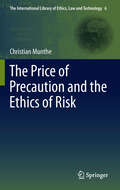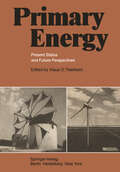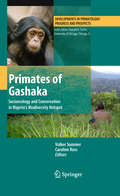- Table View
- List View
Prevention of Pollution of the Marine Environment from Vessels: The Potential and Limits of the International Maritime Organisation
by Md Saiful KarimThis book examines the role of The International Maritime Organization (IMO) in the prevention and control of pollution of the marine environment from vessels with a particular reference to the current north-south tensions regarding the strategy for combating climate change in the maritime sector as well as the prevention of marine pollution from the ship-breaking industry.The IMO, a United Nations specialized agency, has been entrusted with the duty to provide machinery for cooperation among governments for the prevention and control of pollution of the marine environment from vessels. The organization is responsible for drafting legal instruments as well as for facilitating technical cooperation for the protection of the marine environment. Although IMO legal instruments are mainly targeted at the prevention of pollution of the marine environment from vessels, there is a trend towards a liberal interpretation of this, and the organization has expanded its work to areas like shipbreaking, which is essentially a land-based industry.
The Price of Blood: A Novel (The Emma of Normandy Series #2)
by Patricia BracewellThe second book in Bracewell’s outstanding Emma of Normandy series, set in 11-century England, when Vikings are on the brink of invasion.
The Price of Climate Action: Philanthropic Foundations in the International Climate Debate
by Edouard MorenaThis book explores how a handful of liberal foundations contributed to establish and orientate the international climate regime. Looking back at the origins of international climate philanthropy and its evolution over the past three decades, the author examines the role of philanthropic foundations in the international climate debate. The research presented in this book shows that foundations, through their grant-making and convening activities, are at the heart of the climate debate. In fact, many credit them with having, through their activities prior to and at the COP, significantly contributed to laying the basis for the Paris Agreement in December 2015.
The Price of Climate Change: Sustainable Financial Mechanisms
by Michael CurleyThe Price of Climate Change: Sustainable Financial Mechanisms presents a summary of the effects of global warming with specific emphasis on what these phenomena will cost and the price we must pay for trying to mitigate these processes. Some of these mitigation strategies include reducing our use of carbon by converting to non-carbon energy sources such as solar, wind, and nuclear, or lower-carbon sources such as natural gas. The book examines the financial implications of society adapting to the effects of climate change, including rising sea levels, extreme weather events, and desertification. Further, it addresses the costs to make buildings more resilient to climate change, such as flood considerations, improving durability against severe weather, bolstering insulation, and more. Sources of funding for any type of environmental projects, including those for climate change mitigation, are also examined. These include governmental budgets at the federal, state, and local levels, international development banks, international capital markets, and private funds. Features: Addresses global climate change issues from the standpoints of mitigation, adaptation, and resilience and the funding mechanisms for each. Describes different types of energy sources as well as their respective costs, including nuclear, solar, natural gas, and more. Examines the effects of agriculture on climate change as well as the potential ways it can be used to help mitigate the issue. The book’s straightforward approach will serve as a useful guide and reference for practicing professionals and can also be appreciated by the general public interested in climate change issues and mitigation strategies.
The Price of Climate Change: Sustainable Financial Mechanisms
by Michael CurleyThe Price of Climate Change: Sustainable Financial Mechanisms presents a summary of the effects of global warming with specific emphasis on what these phenomena will cost and the price we must pay for trying to mitigate these processes. Some of these mitigation strategies include reducing our use of carbon by converting to non-carbon energy sources such as solar, wind, and nuclear, or lower-carbon sources such as natural gas. The book examines the financial implications of society adapting to the effects of climate change, including rising sea levels, extreme weather events, and desertification. Further, it addresses the costs to make buildings more resilient to climate change, such as flood considerations, improving durability against severe weather, bolstering insulation, and more. Sources of funding for any type of environmental projects, including those for climate change mitigation, are also examined. These include governmental budgets at the federal, state, and local levels, international development banks, international capital markets, and private funds. Features: Addresses global climate change issues from the standpoints of mitigation, adaptation, and resilience and the funding mechanisms for each. Describes different types of energy sources as well as their respective costs, including nuclear, solar, natural gas, and more. Examines the effects of agriculture on climate change as well as the potential ways it can be used to help mitigate the issue. The book’s straightforward approach will serve as a useful guide and reference for practicing professionals and can also be appreciated by the general public interested in climate change issues and mitigation strategies.
The Price of Collapse: The Little Ice Age and the Fall of Ming China
by Timothy BrookHow climate change ushered in the collapse of one of history&’s mighty empiresIn 1644, after close to three centuries of relative stability and prosperity, the Ming dynasty collapsed. Many historians attribute its demise to the Manchu invasion of China, but the truth is far more profound. The Price of Collapse provides an entirely new approach to the economic and social history of China, exploring how global climate crisis spelled the end of Ming rule.The mid-seventeenth century witnessed the deadliest phase of the Little Ice Age, when temperatures and rainfall plunged and world economies buckled. Timothy Brook draws on the history of grain prices to paint a gripping portrait of the final tumultuous years of a once-great dynasty. He explores how global trade networks that increasingly moved silver into China may have affected prices and describes the daily struggle to survive amid grain shortages and famine. By the early 1640s, as the subjects of the Ming found themselves caught in a deadly combination of cold and drought that defied all attempts to stave off disaster, the Ming price regime collapsed, and with it the Ming political regime.A masterful work of scholarship, The Price of Collapse reconstructs the experience of ordinary people under the immense pressure of unaffordable prices as their country slid from prosperity to calamity and shows how the market mediated the relationship between an empire and the climate that turned against it.
The Price of Collapse: The Little Ice Age and the Fall of Ming China
by Timothy BrookHow climate change ushered in the collapse of one of history&’s mighty empiresIn 1644, after close to three centuries of relative stability and prosperity, the Ming dynasty collapsed. Many historians attribute its demise to the Manchu invasion of China, but the truth is far more profound. The Price of Collapse provides an entirely new approach to the economic and social history of China, exploring how global climate crisis spelled the end of Ming rule.The mid-seventeenth century witnessed the deadliest phase of the Little Ice Age, when temperatures and rainfall plunged and world economies buckled. Timothy Brook draws on the history of grain prices to paint a gripping portrait of the final tumultuous years of a once-great dynasty. He explores how global trade networks that increasingly moved silver into China may have affected prices and describes the daily struggle to survive amid grain shortages and famine. By the early 1640s, as the subjects of the Ming found themselves caught in a deadly combination of cold and drought that defied all attempts to stave off disaster, the Ming price regime collapsed, and with it the Ming political regime.A masterful work of scholarship, The Price of Collapse reconstructs the experience of ordinary people under the immense pressure of unaffordable prices as their country slid from prosperity to calamity and shows how the market mediated the relationship between an empire and the climate that turned against it.
The Price of Precaution and the Ethics of Risk (The International Library of Ethics, Law and Technology #6)
by Christian MuntheChristian Munthe undertakes an innovative, in-depth philosophical analysis of what the idea of a precautionary principle is and should be about. A novel theory of the ethics of imposing risks is developed and used as a foundation for defending the idea of precaution in environmental and technological policy making against its critics, while at the same time avoiding a number of identified flaws. The theory is shown to have far-reaching practical conclusions for areas such as bio-, information- and nuclear technology, and global environmental policy in areas such as climate change. The author argues that, while the price we pay for precaution must not be too high, we have to be prepared to pay it in order to act ethically defensible. A number of practical suggestions for precautionary regulation and policy making are made on the basis of this, and some challenges to basic ethical theory as well as consumerist societies, the global political order and liberal democracy are identified.Munthe’s book is a well-argued contribution to the PP debate, putting neglected justificatory and methodological questions at the forefront. His many discussions of alternative accounts as well as his drawing out the consequences of his own suggestion in practical cases give the reader a thorough, holistic sense of what justification of PP amounts to. /..../ Munthe’s main case, his argumentation for the requirement of precaution as a moral norm, is convincing and puts a strong pressure on too narrow alternative suggestions on how it should be perceived and justified, and he launches a plausible defence of its practical usability.
Pricing and Forecasting Carbon Markets: Models and Empirical Analyses
by Bangzhu Zhu Julien ChevallierThis book applies the multidisciplinary approaches of econometrics, statistics, finance and artificial intelligence for pricing and forecasting the carbon market in the context of managerial issues. It explores the related issues of pricing and forecasting the carbon market using theoretical models and empirical analyses, demonstrating how the carbon market, as a policy-based artificial market, is complex and influenced by both the market mechanisms and the external heterogeneous environments. By integrating the features of analytical systems, it offers insights to further our scientific understanding of the pricing mechanism and the variable laws governing the carbon market. Moreover, it lays a foundation for dealing with climate change in China and constructing a national carbon market there. Ultimately, it actively contributes to the energy saving and CO2 emission reduction promoted by the carbon market.The carbon market, represented by the European Union Emissions Trading System (EU ETS), is a cost-effective measure for tackling climate change. Furthermore, pricing and forecasting carbon market has been one of the research focuses in the fields of energy and climate change. As a policy tool of the trading mechanism, the carbon market offers a great institutional innovation for coping with climate change. Due to its multiple advantages including saving costs and environment protection, and political feasibility, more and more countries including China have applied the carbon market for carbon dioxide (CO2) emission reduction. Accurately understanding the pricing mechanism and mastering the fluctuating law of carbon market is essential to build a national carbon market for China.
Pricing Carbon in Australia: Contestation, the State and Market Failure (Routledge Advances in Climate Change Research)
by Rebecca PearseIn the mid-2000s it seemed that the global carbon market would take off and spark the worldwide transition to a profitable low carbon economy. A decade on, the experiment in carbon trading is failing. Carbon market schemes have been plagued by problems and resistance to carbon pricing has come from the political Left and Right. In the Australian case, a national emissions trading scheme (ETS) was dismantled after a long, bitter public debate. The replacement ‘Direct Action Plan’ is also in disrepute. Pricing Carbon in Australia examines the rise and fall of the ETS in Australia between 2007 and 2015, exploring the underlying contradictions of marketised climate policy in detail. Through this and other international examples, the book offers a critique of the political economy of marketised climate policy, exploring why the hopes for global carbon trading have been dashed. The Australian case is interpreted in light of a broader legitimation crisis as state strategies for (temporarily) displacing the climate crisis continue to fail. Importantly, in the wake of carbon market failure, alternative agendas for state action are emerging as campaigns for the retrenchment of fossil fuel assets and for just renewable energy transition continue transforming climate politics and policy as we know it. This book is a valuable resource for practitioners and academics in the fields of environmental policy and politics and social movement studies.
Pricing Carbon in Australia: Contestation, the State and Market Failure (Routledge Advances in Climate Change Research)
by Rebecca PearseIn the mid-2000s it seemed that the global carbon market would take off and spark the worldwide transition to a profitable low carbon economy. A decade on, the experiment in carbon trading is failing. Carbon market schemes have been plagued by problems and resistance to carbon pricing has come from the political Left and Right. In the Australian case, a national emissions trading scheme (ETS) was dismantled after a long, bitter public debate. The replacement ‘Direct Action Plan’ is also in disrepute. Pricing Carbon in Australia examines the rise and fall of the ETS in Australia between 2007 and 2015, exploring the underlying contradictions of marketised climate policy in detail. Through this and other international examples, the book offers a critique of the political economy of marketised climate policy, exploring why the hopes for global carbon trading have been dashed. The Australian case is interpreted in light of a broader legitimation crisis as state strategies for (temporarily) displacing the climate crisis continue to fail. Importantly, in the wake of carbon market failure, alternative agendas for state action are emerging as campaigns for the retrenchment of fossil fuel assets and for just renewable energy transition continue transforming climate politics and policy as we know it. This book is a valuable resource for practitioners and academics in the fields of environmental policy and politics and social movement studies.
Pricing Irrigation Water: Principles and Cases from Developing Countries
by Yacov TsurAs globalization links economies, the value of a country's irrigation water becomes increasingly sensitive to competitive forces in world markets. Water policy at the national and regional levels will need to accommodate these forces or water is likely to become undervalued. The inefficient use of this resource will lessen a country's comparative advantage in world markets and slow its transition to higher incomes, particularly in rural households. While professionals widely agree on what constitutes sound water resource management, they have not yet reached a consensus on the best ways of implementing policies. Policymakers have considered pricing water - a debated intervention - in many variations. Setting the price 'right,' some say, may guide different types of users in efficient water use by sending a signal about the value of this resource. Aside from efficiency, itself an important policy objective, equity, accessibility, and implementation costs associated with the right pricing must be considered. Focusing on the examples of China, Mexico, Morocco, South Africa, and Turkey, Pricing Irrigation Water provides a clear methodology for studying farm-level demand for irrigation water. This book is the first to link the macroeconomics of policies affecting trade to the microeconomics of water demand for irrigation and, in the case of Morocco, to link these forces to the creation of a water user-rights market. This type of market reform, the contributors argue, will result in growing economic benefits to both rural and urban households.
Pricing Irrigation Water: Principles and Cases from Developing Countries
by Yacov TsurAs globalization links economies, the value of a country's irrigation water becomes increasingly sensitive to competitive forces in world markets. Water policy at the national and regional levels will need to accommodate these forces or water is likely to become undervalued. The inefficient use of this resource will lessen a country's comparative advantage in world markets and slow its transition to higher incomes, particularly in rural households. While professionals widely agree on what constitutes sound water resource management, they have not yet reached a consensus on the best ways of implementing policies. Policymakers have considered pricing water - a debated intervention - in many variations. Setting the price 'right,' some say, may guide different types of users in efficient water use by sending a signal about the value of this resource. Aside from efficiency, itself an important policy objective, equity, accessibility, and implementation costs associated with the right pricing must be considered. Focusing on the examples of China, Mexico, Morocco, South Africa, and Turkey, Pricing Irrigation Water provides a clear methodology for studying farm-level demand for irrigation water. This book is the first to link the macroeconomics of policies affecting trade to the microeconomics of water demand for irrigation and, in the case of Morocco, to link these forces to the creation of a water user-rights market. This type of market reform, the contributors argue, will result in growing economic benefits to both rural and urban households.
Pricing the Planet's Future: The Economics of Discounting in an Uncertain World
by Christian GollierOur path of economic development has generated a growing list of environmental problems including the disposal of nuclear waste, exhaustion of natural resources, loss of biodiversity, climate change, and polluted land, air, and water. All these environmental problems raise the crucial challenge of determining what we should and should not do for future generations. It is also central to other policy debates, including, for example, the appropriate level of public debt, investment in public infrastructure, investment in education, and the level of funding for pension benefits and for research and development. Today, the judge, the citizen, the politician, and the entrepreneur are concerned with the sustainability of our development. The objective of Pricing the Planet's Future is to provide a simple framework to organize the debate on what we should do for the future. A key element of analysis by economists is the discount rate--the minimum rate of return required from an investment project to make it desirable to implement. Christian Gollier outlines the basic theory of the discount rate and the various arguments that favor using a smaller discount rate for more distant cash flows. With principles that can be applied to many policy areas, Pricing the Planet's Future offers an ideal framework for dynamic problems and decision making.
Pricing the Planet's Future: The Economics of Discounting in an Uncertain World
by Christian GollierOur path of economic development has generated a growing list of environmental problems including the disposal of nuclear waste, exhaustion of natural resources, loss of biodiversity, climate change, and polluted land, air, and water. All these environmental problems raise the crucial challenge of determining what we should and should not do for future generations. It is also central to other policy debates, including, for example, the appropriate level of public debt, investment in public infrastructure, investment in education, and the level of funding for pension benefits and for research and development. Today, the judge, the citizen, the politician, and the entrepreneur are concerned with the sustainability of our development. The objective of Pricing the Planet's Future is to provide a simple framework to organize the debate on what we should do for the future. A key element of analysis by economists is the discount rate--the minimum rate of return required from an investment project to make it desirable to implement. Christian Gollier outlines the basic theory of the discount rate and the various arguments that favor using a smaller discount rate for more distant cash flows. With principles that can be applied to many policy areas, Pricing the Planet's Future offers an ideal framework for dynamic problems and decision making.
Prick: Cacti and Succulents: Choosing, Styling, Caring
by Gynelle LeonPrick is a stylish, practical, modern guide to the world of cacti and succulents."A comprehensive guide" BBC Gardeners' World MagazineCacti and succulents are the plant of the moment. Beautiful, affordable and - if you know how - easy to care for, they're a short cut to creating brighter, calmer, more relaxing spaces in the home and office.In Prick, cactus and succulent expert Gynelle Leon gives you all the knowledge you need to help your plants thrive in a simple, easy-to-understand way. Featuring: A plant gallery, showcasing the many weird and wonderful varieties A chapter of styling ideas to show off your plants A care guide to help your cacti and succulents flourishAs an RHS-award-winning plant photographer and founder of London's only shop dedicated to cacti and succulents, Gynelle is the perfect guide on your path to cactus know-how.
Prickly Moses: Poems
by Simon WestCompelling poems that celebrate language as it encounters the nameless variety of the natural world, from Australia to ItalyAn uncanny blend of the external and the intimate has been a hallmark of Simon West’s poetry for nearly twenty years. In this new collection, the Australian poet and Italianist delights in the transforming and endlessly varied powers of naming and speaking. West’s intensely regional focus stands in dialogue with Europe and antiquity. Landscapes reveal the tangle of their historical dimensions, as the rivers of both the Goulburn Valley in southeastern Australia and the Po Valley in northern Italy merge and flow into the wider currents of the Southern Ocean. Again and again, language and the senses throw themselves into the nameless riot of the world, from eucalypts and clouds to a medieval bell tower and the sounds a pencil makes as it crosses a page.
Primary Energy: Present Status and Future Perspectives
by Klaus O. ThielheimThe enormous public interest of specialists as well as of engaged and concerned citizens in the energy problem can be understood in view of the fact that the future of national and world-wide economy depends on the availability of sufficient primary energy. The questions arising are: which forms of primary energy exist principally? by what means and at what cost can they be brought to useful application? and what is their possible role in the present and future energy scenario? Another reason which may not be so obvious, but which eventually may prove to be of great importance as far as public acceptance of energy technologies is con cerned, lies in the fact that the existing conscious or subconscious fears arising from confrontation with scientific and technological progress - to which even for the educated layman intellectual access is diffi cult - have been sublimated onto the energy problem and especially onto the problem of nuclear energy. Un like other developments, the emergence of nuclear ener gy has brought to our notice the ambivalence of ad vancing science and technology, which may either be used peacefully or misused militarily. Nuclear energy can help to overcome the increasing hunger for energy in the world, but it can also lead to the extinction of human life from the surface of this plant. More and more, mankind is confronted with chances and risks of new discoveries.
Primary Wood Processing: Principles and Practice
by John C.F. WalkerThis book is primarily a general text covering the whole sweep of the forest industries. The over-riding emphasis is on a clear, simple interpretation of the underlying science, demonstrating how such principles apply to processing operations. The book considers the broad question "what is wood?" by looking at the biology, chemistry and physics of wood structure. Wood quality is examined, and explanations are offered on how and why wood quality varies and the implications for processing. Finally, various "industrial processes" are reviewed and interpreted. All chapters have been written by specialists, but the presentation targets a generalist audience.
Primate Life Histories, Sex Roles, and Adaptability: Essays in Honour of Linda M. Fedigan (Developments in Primatology: Progress and Prospects)
by Urs Kalbitzer Katharine M. JackProfessor Linda M. Fedigan, Member of the Order of Canada and a Fellow of the Royal Society of Canada, has made major contributions to our understanding of the behavioural ecology of primates. Furthermore, Linda Fedigan pioneered and continues to advance scholarship on the role of women in science, as well as actively promoting the inclusion of women in the academy. A symposium in honour of her career was held in Banff (Alberta, Canada) in December 2016, during which former and current students and collaborators, as well as scientists with similar research interests, presented and discussed their work and their connections to Linda Fedigan. These presentations and discussions are here presented as chapters in this festschrift. The original works presented in this book are organized around four major research areas that have been greatly advanced and influenced by Linda Fedigan:Primate life historiesSex roles, gender, and sciencePrimate-environment interactionsPrimate adaptation to changing environments
A Primate's Memoir: A Neuroscientist's Unconventional Life Among The Baboons (Thorndike Press Large Print Adventure Ser.)
by Robert M SapolskyBook-smart and more than a little naive, Robert Sapolsky left the comforts of college in the US for a research project studying a troop of baboons in Kenya. Whether he's relating his adventures with his neighbours, Masai tribesmen, or his experiences learning how to sneak up and dart suspicious baboons, Sapolsky combines irreverence and humour with the best credentials in his field. A Primate's Memoir is the culmination of over two decades of experience and research - an exhilarating, hilarious and daring memoir, and an astonishing masterpiece of the people and nature of Africa.
Primates of Gashaka: Socioecology and Conservation in Nigeria’s Biodiversity Hotspot (Developments in Primatology: Progress and Prospects #35)
by Volker Sommer and Caroline RossThe Gashaka Primate Project has grown into one of the largest research and conservation activities in West Africa. At present, it keeps going on the initiative of the editors of this volume and their academic home institutions.The appearance of this volume marks the 10th anniversary of the Gashaka Primate Project
A Primer on Human Impacts on the Environment: The Conceptual Approach
by Liam HeneghanA Primer on Human Impacts on the Environment An insightful and illuminating discussion of the impact humans have had on Earth In A Primer on Human Impacts on the Environment: The Conceptual Approach, distinguished environmental scientist Liam Heneghan explores the intricate relationships between humanity and Earth in an accessible and engaging style. Replete with real-world examples and drawing from classic and contemporary scholarship, the author adapts the fundamental conceptual models of the environmental disciplines to assess the risks human beings are taking with their home planet. The conceptual approach of this primer challenges readers to think across multiple disciplines to reveal the “big picture” that is all too often lost in the details of contemporary environmental studies. Readers will also find: A thorough introduction to conceptual modeling, showing how systems models can be adapted and applied in a rapidly changing world Comprehensive explorations of the human impact on the Earth, including an examination of possible ecological limits and planetary boundaries In-depth evaluations of environmental risks, especially, though not limited to, climate change and biodiversity loss A guide to contemplating catastrophic risk and the potential for societal collapse without inducing unnecessary anxiety An interdisciplinary focus, emphasizing the role of the natural and social sciences, as well as the arts and humanistic disciplines in safeguarding the future Perfect for students of environmental science and environmental studies, A Primer on Human Impacts on the Environment will also earn a place in the libraries of graduate students working on environmental themes and practicing professionals in the environmental management community.
A Primer on Human Impacts on the Environment: The Conceptual Approach
by Liam HeneghanA Primer on Human Impacts on the Environment An insightful and illuminating discussion of the impact humans have had on Earth In A Primer on Human Impacts on the Environment: The Conceptual Approach, distinguished environmental scientist Liam Heneghan explores the intricate relationships between humanity and Earth in an accessible and engaging style. Replete with real-world examples and drawing from classic and contemporary scholarship, the author adapts the fundamental conceptual models of the environmental disciplines to assess the risks human beings are taking with their home planet. The conceptual approach of this primer challenges readers to think across multiple disciplines to reveal the “big picture” that is all too often lost in the details of contemporary environmental studies. Readers will also find: A thorough introduction to conceptual modeling, showing how systems models can be adapted and applied in a rapidly changing world Comprehensive explorations of the human impact on the Earth, including an examination of possible ecological limits and planetary boundaries In-depth evaluations of environmental risks, especially, though not limited to, climate change and biodiversity loss A guide to contemplating catastrophic risk and the potential for societal collapse without inducing unnecessary anxiety An interdisciplinary focus, emphasizing the role of the natural and social sciences, as well as the arts and humanistic disciplines in safeguarding the future Perfect for students of environmental science and environmental studies, A Primer on Human Impacts on the Environment will also earn a place in the libraries of graduate students working on environmental themes and practicing professionals in the environmental management community.
A Primer on Nonmarket Valuation (The Economics of Non-Market Goods and Resources #13)
by Patricia A. Champ Kevin J. Boyle Thomas C. BrownThis is a practical book with clear descriptions of the most commonly used nonmarket methods. The first chapters of the book provide the context and theoretical foundation of nonmarket valuation along with a discussion of data collection procedures. The middle chapters describe the major stated- and revealed-preference valuation methods. For each method, the steps involved in implementation are laid out and carefully explained with supporting references from the published literature. The final chapters of the book examine the relevance of experimentation to economic valuation, the transfer of existing nonmarket values to new settings, and assessments of the reliability and validity of nonmarket values.The book is relevant to individuals in many professions at all career levels. Professionals in government agencies, attorneys involved with natural resource damage assessments, graduate students, and others will appreciate the thorough descriptions of how to design, implement, and analyze a nonmarket valuation study.


















